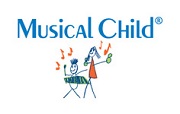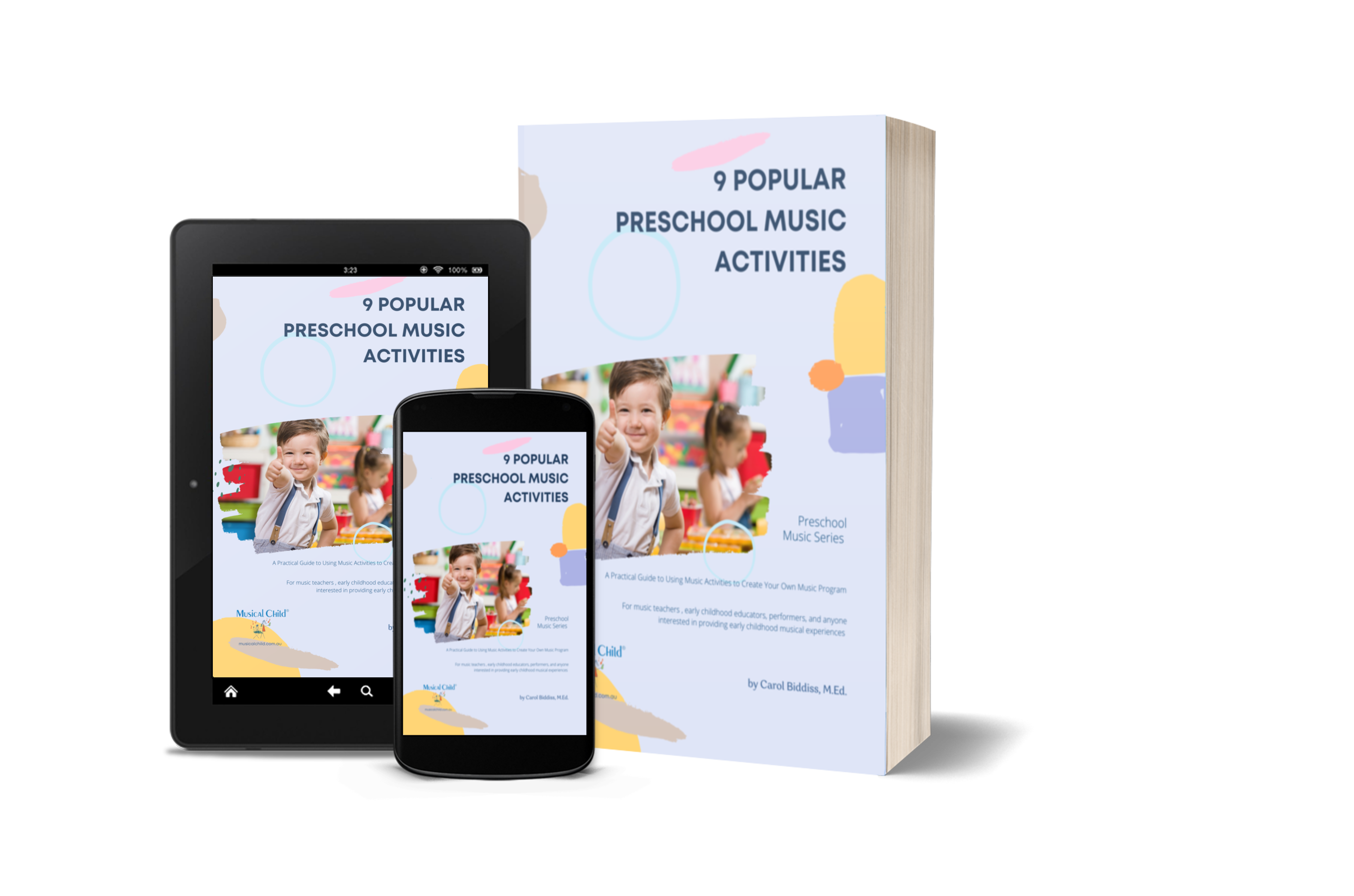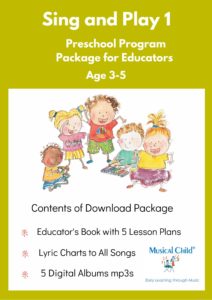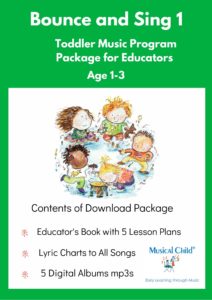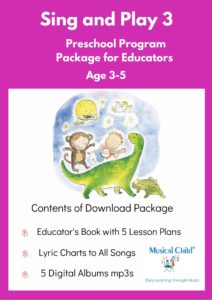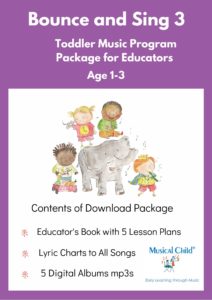EYLF Outcomes (Early Years Learning Framework) – Music and Movement
The EYLF – Early Learning Outcomes
We invite you to discover Musical Child’s alignments with the 5 early learning outcomes from the Australian Early Years Learning Framework (EYLF).
Outcome 1: Children have a strong sense of identity
Children learn to interact in relation to others with care, empathy and respect
This is evident when they “engage in and contribute to shared play experiences [with play songs].”
Educators promote this learning when they “initiate one-to-one [play song] interactions with children, particularly babies and toddlers, during daily routines.” (EYLF p. 24)
Musical knowledge and musical preference are very strong markers of identity for the whole of life. The traditional songs of childhood are an extremely important resource for educators to draw from when working to establish a strong sense of identity. Children who know many songs are more likely to have a confident self identity.
Research has shown that toddlers interact positively with other people of various ages who have songs and dances in common with them. Songs/dances/ceremonies shared by a cultural group are critical for maintaining inter-dependence and resilience, and a strong sense of group identity.
Children develop knowledgeable and confident self-identities
This is evident when a child feels “recognised and respected for who they are”. Transitions are often stressful. For a child entering or leaving a group, educators can soften the transition by singing a greeting or farewell, promoting “in all children a strong sense of who they are and their connection to others — a shared identity as Australians.” (EYLF p. 23)
A child who is included in musical activities develops a positive sense of self. The act of greeting and/or farewelling by name enhances each child’s sense of personal identity. Groups of children listening for each other’s names being sung, gain a confident sense of who’s in the group. They know with whom they belong. They share a group identity. e.g Hello Song; Goodbye Song.
There are many songs scattered throughout the Musical Child programs that call for the inclusion of individual children’s names e.g. Ruby Goes High; Clap Handies; Oh Susanna.
For more information, investigate the baby sensory play songs module in the self-paced training series
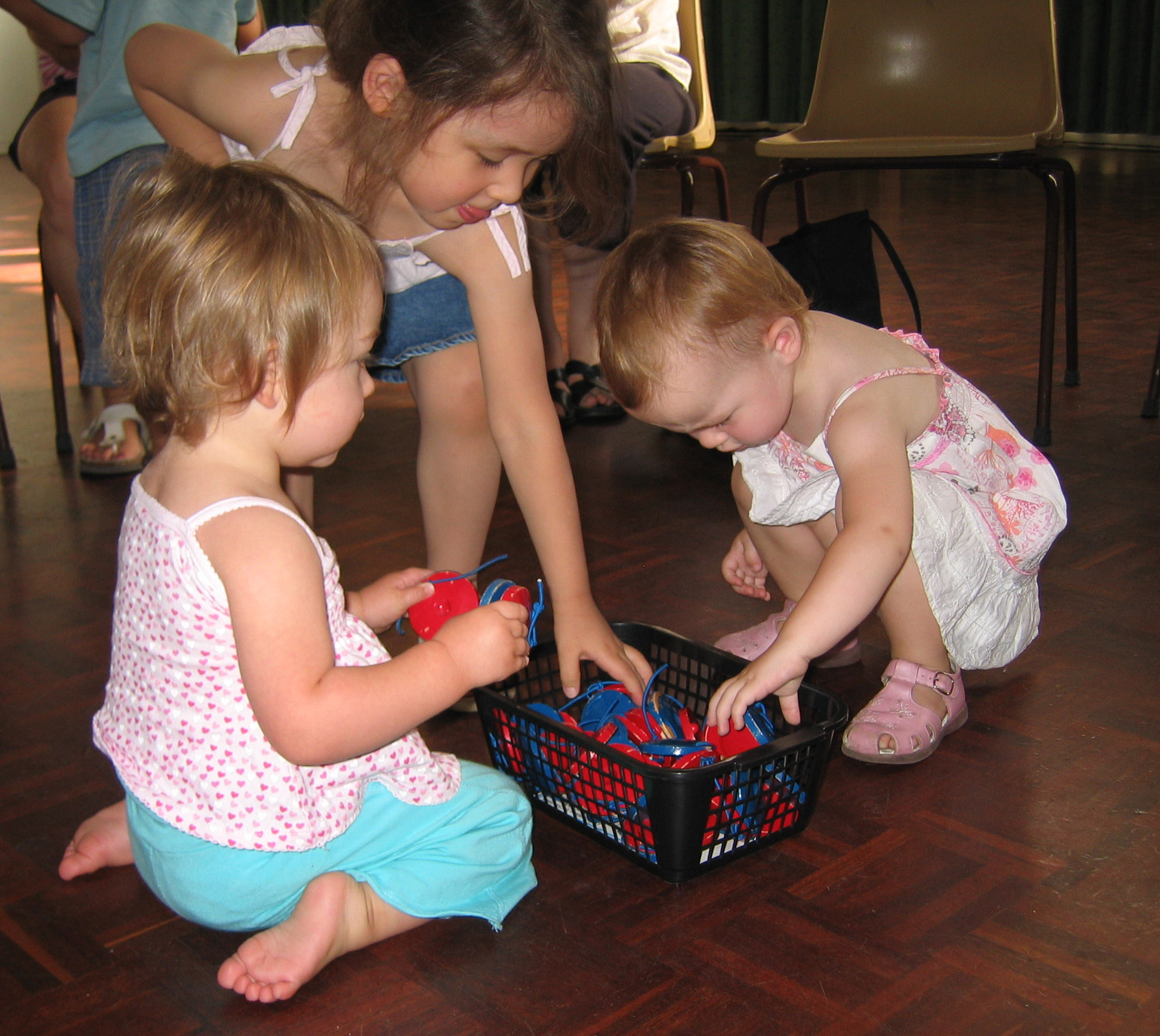
FREE Micro-Course '9 Popular Preschool Music Activities' PDF
This micro-course and PDF is your practical guide to finding out what kind of activities you can easily do that children love.
Outcome 2. Children are connected with and contribute to their world
Children respond to diversity with respect
This is evident when babies and young children “explore the diversity of culture, heritage, background and tradition [in music, movement and dance]”. (EYLF p. 27)
Educators promote this learning when they expose children to different language songs, culturally different music, musical instruments and dances, and encourage appreciation of, and participation in, diverse musical and movement expressions.
Music Appreciation: when children listen to and move/dance to recordings from diverse cultures, they are connected to current and past shared worlds of significant music. e.g. David Hudson, Solo Didgeridoo ‘Wongabell’ from Yigi, Yigi ; and George Frideric Handel Royal Fireworks Music – La Rejouissance.
Drama and Movement: when children interact with each other while playing musical games, they contribute to the social fabric in their homes or centres. They also learn to creatively handle props, coordinate their body parts; and manage indoor spaces. e.g Click Go the Shears; Kata Alipiri (Pit.); Alley Alley Oo.
For more information take a look at our babies and dance self-training module.
Outcome 3. Children have a strong sense of wellbeing
Children become strong in their social and emotional wellbeing
This is evident when they “demonstrate trust and confidence” in their carers/educators.
Educators support this learning when they “ show genuine affection, understanding and respect” as they sing soothing songs to babies. (EYLF p. 31)
Singing lullabies is one of the many ways that musical activities support children’s emotional, social and even their physical well-being.
Lullabies offer a time for quiet restoration. The ritual of listening in a resting position is designed to achieve relaxation through entrainment with the music. We know from recent research that lullabies are sung all over the world to ease the child into a restful state, often just before sleep. The low, soft, intimate voice soothes both adult and child. Sometimes the singing is coupled with steady rocking rhythms or swaying movements, patting or cuddling – e.g. Lu-la Bye Bye; Cockles and Mussels.
For more information take a look at our lullabies self-training module.
Outcome 4. Children are confident and involved learners
Children develop a range of skills and processes such as problem solving, inquiry, experimentation, hypothesising, researching and investigating
This is evident when babies who are regularly bounced in time to music “make predictions and generalisations about . . . aspects of the natural world and environments, using patterns they . . . identify”. They extend their innate skills in hypothesising.
Educators promote this learning when they “provide experiences that encourage children to investigate and solve problems” and “model mathematical and scientific language and language associated with the arts.” (EYLF p. 35)
Knee Bounce activities for babies and toddlers internalise the strong driving beat of the song. The feeling of the beat goes directly into the body of the child, either by bouncing on an adult’s knee or by encouraging the child to bounce on their own haunches. In our musical arrangements, the song is played three times with each repetition at a faster tempo to increase excitement and joy. The Bounce track lasts approximately one minute. e.g. Bell Horses; Rub-a-dub-dub.
For more information, see the training module on how to bounce a baby so they learn the rhythmic patterns of their culture.
Apart from Baby Bounces, there are many other musical activities that support confident and involved learning. A few examples follow:
Children develop dispositions for learning such as curiosity, cooperation, confidence, creativity, commitment, enthusiasm, persistence, imagination and reflexivity
This is evident when children happily learn Transition Songs such as a song for packing up after an activity is finished. Through singing the song, children enjoy a game of looking after the things provided for them. They learn to use teamwork. They come to understand when one activity finishes and another begins. And they gain a growing understanding of where things are stored so they can easily access them the next time. e.g. Pack Away Song
Drama and Movement Songs: when children are ‘curious and enthusiastic participants’ pretending to ride or be horses, they make use of their whole body to connect with their world through a strong sense of dramatic play. They imagine other environments while navigating through indoor spaces. Educators promote this learning when they ‘provide learning environments that are flexible and open-ended.’ (EYLF p. 34) e.g.The Little Horses by the Creek (Toddlers); I Have a Little Pony (Preschool).
For more information on drama and movement, see any of the toddler or preschool music programs. e.g. Bouncing on the Bed
Outcome 5. Children are effective communicators
Children engage with a range of texts and gain meaning from these texts
This is evident when babies “begin to understand key literacy and numeracy concepts and processes, such as the sounds of language . . . and the way that texts are structured.
Educators support this learning when they “sing and chant [nursery] rhymes”.
“In the early years, literacy includes a range of modes of communication including music, movement, dance, story telling, visual arts, media and drama, as well as talking, reading and writing.” (EYLF p. 41)
Story telling with nursery rhymes is mesmeric and trance-inducing, providing time for children to concentrate on learning speech forms. Among other benefits, these rich parcels of language develop vocabulary — including rare words, and prosody — the vocal patterns in a language that lend emotional substance.
Nursery rhymes also fulfill the growing need for narrative structure as children develop their awareness of people, time, event and place and the way they interconnect e.g. Hey Diddle Diddle; or Jack and Jill. Another purpose of the nursery rhyme is to teach basic knowledge such as rudimentary counting skills e.g. Baa Baa Black Sheep.
For toddlers and preschoolers, after physical activity it is appropriate to calm the children so they can rest and integrate the changes to their bodies. Nothing works better than story-time to interest them and change the mood and help with children’s learning. We have chosen stories that are sung adding a musical dimension to this important shared literary experience e.g. Ten in the Bed; or Three Little Kittens.
Children become effective communicators when they are given great examples of communication. Songs have been used for millennia to carry meaningful information in easily memorised chunks, underpinned by rhythm, rhyme and repetition – the ‘real 3 Rs’. Memory songs help us remember those things we just have to learn by heart – the sequence of the numbers both forwards and backwards e.g. One Man went to Mow; the names and sequence of the days in the week e.g. Days of the Week; initial sounds of words in the phonics system e.g. B-b Baby Bilby; or first steps in learning another language e.g Taba Naba Norem (Torres Strait Is.)
For an in depth study of how and when babies learn which sounds they need for speech, see the training module on the importance of nursery rhymes for phonetic learning in infancy
References
- Belonging, Being and Becoming: The Early Years Learning Framework for Australia, 20022 Produced by the Australian Government Department of Education, Employment and Workplace Relations for the Council of Australian Governments.
The Early Years Learning Framework for Australia V2 (EYLF)
Get Your FREE Educator's Resource Here
Sign-up to Receive a FREE Guide on How to Teach Preschool Music Activities.
Inside this Mini-course you will be able to download a beautiful PDF and a collection of 20 MP3s. You will learn how to deliver nine popular preschool music activities that your children will LOVE!
(p.s. It's a mini-course, that means you'll be in and out in minutes with fresh resources you can use immediately with your children.)
(p.p.s. You also get a bonus lesson on what instruments to use with preschoolers. 🪇)
